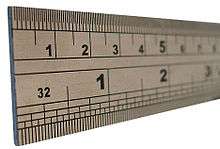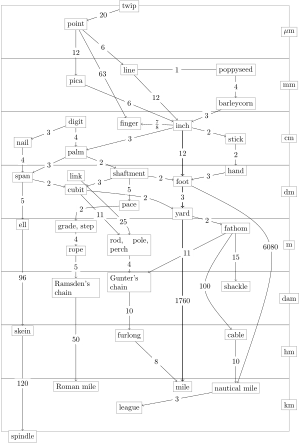Unit of length
A unit of length refers to any arbitrarily chosen and accepted reference standard for measurement of length. The most common units in modern use are U.S. customary units in the United States and metric units elsewhere. British Imperial units are still used for some purposes in the United Kingdom and some other countries. The metric system is sub-divided into SI and non-SI units.[1][2][3]

Metric system
SI
The base unit in the International System of Units (SI) is the metre, defined as "the length of the path travelled by light in vacuum during a time interval of 1⁄299792458 seconds."[4] It is approximately equal to 1.0936 yd. Other units are derived from the metre by adding prefixes from the table below:
| Prefix name | N/A | deca | hecto | kilo | mega | giga | tera | peta | exa | zetta | yotta |
|---|---|---|---|---|---|---|---|---|---|---|---|
| Prefix symbol | da | h | k | M | G | T | P | E | Z | Y | |
| Factor | 100 | 101 | 102 | 103 | 106 | 109 | 1012 | 1015 | 1018 | 1021 | 1024 |
| Prefix name | N/A | deci | centi | milli | micro | nano | pico | femto | atto | zepto | yocto |
|---|---|---|---|---|---|---|---|---|---|---|---|
| Prefix symbol | d | c | m | μ | n | p | f | a | z | y | |
| Factor | 100 | 10–1 | 10–2 | 10–3 | 10–6 | 10–9 | 10–12 | 10–15 | 10–18 | 10–21 | 10–24 |
For example, a kilometre is 1000 m. A slang term for the kilometre in the US and UK militaries is klick.[5][6]
Non-SI
In the Centimetre–gram–second system of units, the basic unit of length is the centimetre, or 1⁄100 of a metre. Other non-SI units are derived from decimal multiples of the metre.
| Name | Symbol | SI value |
|---|---|---|
| fermi | fm | femtometre |
| ångström | Å | 100 picometres |
| micron | μm | 1 micrometre |
| Norwegian/Swedish mil or myriametre | 10,000 metres | |
| x unit | xu | 0.1 picometre |
Imperial/US

The basic unit of length in the Imperial and U.S. customary systems is the yard, defined as exactly 0.9144 m by international treaty in 1959.[2][7]
Common Imperial units and U.S. customary units of length include:[8]
Marine
In addition, the following are used by sailors:
- fathom (for depth; only in non-metric countries) (2 yards = 1.8288 m)
- nautical mile (one minute of arc of latitude = 1852 m)
Aviation
Aviators use feet for altitude worldwide (except in Russia and China) and nautical miles for distance.
Surveying

Surveyors in the United States continue to use:
Science
Astronomy
Astronomical measure uses:
- Earth radius R⊕ ≈ 6,371 km[9]
- Lunar distance LD ≈ 384402 km.[10] Average distance between the center of Earth and the center of the Moon.
- astronomical unit au. Defined as 149597870700 m.[11] Approximately the distance between the Earth and Sun.
- light-year ly ≈ 9460730472580.8 km. The distance that light travels in a vacuum in one Julian year.[12]
- parsec pc ≈ 30856775814671.9 km or about 3.26156 ly
- Hubble length 14.4 billion light-years or 4.55 gigaparsecs
Physics
In atomic physics, sub-atomic physics, and cosmology, the preferred unit of length is often related to a chosen fundamental physical constant, or combination thereof. This is often a characteristic radius or wavelength of a particle. Some common natural units of length are included in this table:
| Atomic property | Symbol | Length, in metres | Reference |
|---|---|---|---|
| The classical electron radius | re | 2.817940285(31)×10−15 | [13] |
| The Compton wavelength of the electron | λC | 2.426310215(18)×10−12 | [13] |
| The reduced Compton wavelength of the electron | 3.8615926764(18)×10−13 | [14] | |
| The Compton wavelength (or reduced Compton wavelength) of any fundamental particle | |||
| The Bohr radius of the hydrogen atom (Atomic unit of length) | a0 | 5.291772083(19)×10−11 | [13] |
| The reduced wavelength of hydrogen radiation | 1 / R∞ | 9.112670505509(83)×10−8 | [13] |
| The Planck length | 𝓁P | 1.616199(97)×10−35 | [15] |
| Stoney unit of length | lS | 1.381×10−35 | |
| Quantum chromodynamics (QCD) unit of length | lQCD | 2.103×10−16 | |
| Natural units based on the electronvolt | 1 eV−1 | 1.97×10−7 |
Archaic
Archaic units of distance include:
Informal
In everyday conversation, and in informal literature, it is common to see lengths measured in units of objects of which everyone knows the approximate width. Common examples are:
- Double-decker bus (9.5–11 metres in length)
- Football field (generally around 110 metres in length)
- Thickness of a human hair (around 80 micrometres)
Other
Horse racing and other equestrian activities keep alive:
- furlong ≈ 0.125 miles (201 m)
- horse length ≈ 8 feet (2.4 m)
See also
References
- Cardarelli, François (2003). Encyclopaedia of Scientific Units, Weights, and Measures: Their SI Equivalences and Origins. Springer. ISBN 9781852336820.CS1 maint: ref=harv (link)
- Hinkelman, Edward G.; Sibylla Putzi (2005). Dictionary Of International Trade: Handbook Of The Global Trade Community. World Trade Press. p. 245. ISBN 9781885073723.
- Judson, Lewis Van Hagen (1960). Units of Weight and Measure (United States Customary and Metric): Definitions and Tables of Equivalents, Issue ,233. U.S. Department of Commerce, National Bureau of Standards. pp. 3–4. Retrieved 16 October 2012.
- "17th General Conference on Weights and Measures (1983), Resolution 1". Retrieved 2012-09-19.
- "MARINE CORPS JARGON" (PDF). hqmc.marines.mil. Retrieved 3 March 2017.
- Rod Powers. "How Far is a 'Klick' in the Military?". About.com. Archived from the original on 17 February 2006. Retrieved 13 April 2010.
- Donald Fenna (26 October 2002). A dictionary of weights, measures, and units. Oxford University Press. pp. 130–1. ISBN 978-0-19-860522-5. Retrieved 8 January 2012.
- Cardarelli 2003, pp. 29–30
- Moritz, H. (March 2000). "Geodetic Reference System 1980". Journal of Geodesy. 74 (1): 128–133. Bibcode:2000JGeod..74..128.. doi:10.1007/s001900050278.
- Battat, J. B. R.; Murphy, T. W.; Adelberger, E. G. (January 2009). "The Apache Point Observatory Lunar Laser-ranging Operation (APOLLO): Two Years of Millimeter-Precision Measurements of the Earth-Moon Range". Astronomical Society of the Pacific. 121 (875): 29–40. Bibcode:2009PASP..121...29B. doi:10.1086/596748. JSTOR 10.1086/596748.
- Geoff Brumfiel (14 Sep 2012). "The astronomical unit gets fixed: Earth–Sun distance changes from slippery equation to single number". Retrieved 14 Sep 2012.
- The IAU and astronomical units, International Astronomical Union, retrieved 2008-07-05
- Quinn, T.J.; Leschiutta, S.; Tavella, P. (August 2000). Recent advances in metrology and fundamental constants. Amsterdam ; Washington, DC: IOS Press, 2001. Proceedings of the International School of Physics "Enrico Fermi". pp. 142–143. ISBN 9781586031671.
- "Compton wavelength over 2 pi". The NIST Reference on Constants, Units, and Uncertainty. NIST. Retrieved 15 October 2012.
- "Planck length". The NIST Reference on Constants, Units, and Uncertainty. NIST. Retrieved 15 October 2012.
Further reading
- Whitelaw, Ian (2007). A Measure of All Things: The Story of Man and Measurement. Macmillan. ISBN 9780312370268.